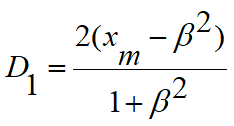SCF specification is standard, and the specified SCF values multiply the stresses calculated by Flexcom/LifeFrequency to account for various stress raisers.
For S-N curve specification, a range of options is provided to allow a wide degree of generality. A particular curve may be defined by two parameters m and K such that the curve is given by NSm = K, where S represents stress range and N number of cycles to failure. Such a curve plots as a straight line on log-log scales. An endurance limit (a stress range below which no fatigue damage results regardless of the number of cycles) may be optionally specified. Alternatively, a series of m and K values may define the curve over particular regions, representing a piecewise-linear log-log plot. In the most general case, a particular curve may be specified as a series of (S, N) data pairs.
The specification of a threshold thickness allows you to take account of the fact that the fatigue strength of some structural members can be dependent on material thickness, with fatigue strength decreasing with increasing thickness. If you specify a threshold thickness for a particular hot spot set, the stresses calculated by Flexcom/LifeFrequency are further multiplied by a factor ![]() given by:
given by:

Here ![]() is the threshold thickness you specify; and
is the threshold thickness you specify; and ![]() is the greater of
is the greater of ![]() and the actual thickness of the particular location under consideration (this ensures that
and the actual thickness of the particular location under consideration (this ensures that ![]() is always greater than or equal to 1). Note that although
is always greater than or equal to 1). Note that although ![]() is specified for a hot spot set,
is specified for a hot spot set,![]() is computed individually for each location in the set, since the structure thickness may vary within a hot spot set. The exponent value n can also be specified and defaults to 4. The specification of
is computed individually for each location in the set, since the structure thickness may vary within a hot spot set. The exponent value n can also be specified and defaults to 4. The specification of ![]() is optional for each set; by default thickness effects are omitted.
is optional for each set; by default thickness effects are omitted.
Finally, a particular hot spot can belong to a number of hot spot sets, each with a different SCF and/or S-N curve and/or threshold thickness. In this way the effect of variations in these parameters can be evaluated in a single LifeFrequency run.
•*FATIGUE DATA is used to assign fatigue data to hot spot sets.
•*HOT SPOT SETS is used to define the fatigue analysis hot spots - these are the locations on the structure for which fatigue life estimates are required.
•*PDF is used to specify the probability density function to be used in calculating fatigue life estimates from stress spectra.
•*PROPERTIES is used to assign effective structural properties to hot spot sets for use in calculating stresses.
•*S-N CURVE is used to define fatigue analysis S-N curves.
If you would like to see an example of how these keywords are used in practice, refer to A01 - Deepwater Drilling Riser or B01 - Steel Catenary Riser.